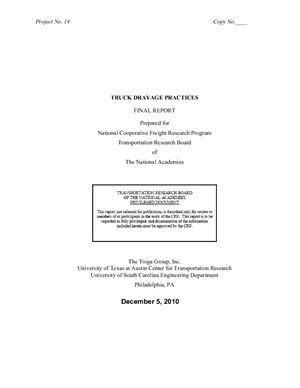TRB, National Academy of Sciences, 2010. 105 p.
Truck Drayage Productivity Guide Appendices contain the Final Report on development of NCFRP Report 11, its appendices and Presentations
Truck Drayage Productivity Guide is designed to help improve drayage productivity and capacity while reducing emissions, costs, and port-area congestion at deepwater ports. The guide includes suggestions designed help shippers, receivers, draymen, marine terminal operators, ocean carriers, and port authorities address inefficiencies, control costs, and reduce associated environmental impacts of truck drayage.
The guide identifies and quantifies the impacts of bottlenecks, associated gate processes, exceptions (trouble tickets), chassis logistics, congestion, and disruption at marine container terminals. The impacts are described in terms of hours, costs, and emissions that were estimated using the Environmental Protection Agency’s DrayFLEET model.
Table of Contents
Acknowledgements
Abstract
Executive Summary
Introduction
Research Approach
Findings and Conclusions
Summary Recommendations
Chapter 1: Overview of Marine Drayage
Marine Drayage Industry
Intermodal Equipment
Marine Terminals
Chapter 2: Research Approach
Overview
Ports
Initial Stakeholder Workshops
Literature Review
Field Work and Site Visits
Port Drayage Process Maps
Marine Terminal Data
GPS/AVL Data
Marine Terminal Webcam Data
Driver and Drayage Firm Surveys
Cost and Emissions Modeling
Final Stakeholder Workshops
Chapter 3: Findings and Applications
Introduction
Drayage Tu Times
Nature of the Problem – Surges and Buffers
Gate Queue Frequency and Length
Marine Terminal Bottlenecks
Gate Processing Bottlenecks
Gate Processing Best Practices
APM Portsmouth Example
Demand Management
Marine Terminal Process Exceptions: Trouble Tickets
Trouble Ticket Solutions And Best Practices
Container Yard (CY) Congestion
Marine Terminal Capacity Management: Best Practices
Chassis Supply Bottlenecks
Chassis Maintenance Bottlenecks
Changing Market Structure for Chassis
Dry Runs and Extra drayage trips
Extra Trip Solutions
Drayage Costs and Emissions Modeling
Chapter 4: Recommendations
Overview
Importer and exporter Recommendations
Marine terminal Recommendations
Motor carrier Recommendations
Ocean carrier Recommendations
Port authority Recommendations
Recommendation for All parties
Appendices (bound separately)
A. Port Selection and Stakeholder Meetings
B. Literature Review
C. Fieldwork and Site Visits
D. Port Drayage Process and Process Maps
E. Webcam and Geofencing Data Collection
F. Driver and Drayage Firm Surveys
G. Cost and Emissions Modeling
Truck Drayage Productivity Guide Appendices contain the Final Report on development of NCFRP Report 11, its appendices and Presentations
Truck Drayage Productivity Guide is designed to help improve drayage productivity and capacity while reducing emissions, costs, and port-area congestion at deepwater ports. The guide includes suggestions designed help shippers, receivers, draymen, marine terminal operators, ocean carriers, and port authorities address inefficiencies, control costs, and reduce associated environmental impacts of truck drayage.
The guide identifies and quantifies the impacts of bottlenecks, associated gate processes, exceptions (trouble tickets), chassis logistics, congestion, and disruption at marine container terminals. The impacts are described in terms of hours, costs, and emissions that were estimated using the Environmental Protection Agency’s DrayFLEET model.
Table of Contents
Acknowledgements
Abstract
Executive Summary
Introduction
Research Approach
Findings and Conclusions
Summary Recommendations
Chapter 1: Overview of Marine Drayage
Marine Drayage Industry
Intermodal Equipment
Marine Terminals
Chapter 2: Research Approach
Overview
Ports
Initial Stakeholder Workshops
Literature Review
Field Work and Site Visits
Port Drayage Process Maps
Marine Terminal Data
GPS/AVL Data
Marine Terminal Webcam Data
Driver and Drayage Firm Surveys
Cost and Emissions Modeling
Final Stakeholder Workshops
Chapter 3: Findings and Applications
Introduction
Drayage Tu Times
Nature of the Problem – Surges and Buffers
Gate Queue Frequency and Length
Marine Terminal Bottlenecks
Gate Processing Bottlenecks
Gate Processing Best Practices
APM Portsmouth Example
Demand Management
Marine Terminal Process Exceptions: Trouble Tickets
Trouble Ticket Solutions And Best Practices
Container Yard (CY) Congestion
Marine Terminal Capacity Management: Best Practices
Chassis Supply Bottlenecks
Chassis Maintenance Bottlenecks
Changing Market Structure for Chassis
Dry Runs and Extra drayage trips
Extra Trip Solutions
Drayage Costs and Emissions Modeling
Chapter 4: Recommendations
Overview
Importer and exporter Recommendations
Marine terminal Recommendations
Motor carrier Recommendations
Ocean carrier Recommendations
Port authority Recommendations
Recommendation for All parties
Appendices (bound separately)
A. Port Selection and Stakeholder Meetings
B. Literature Review
C. Fieldwork and Site Visits
D. Port Drayage Process and Process Maps
E. Webcam and Geofencing Data Collection
F. Driver and Drayage Firm Surveys
G. Cost and Emissions Modeling

